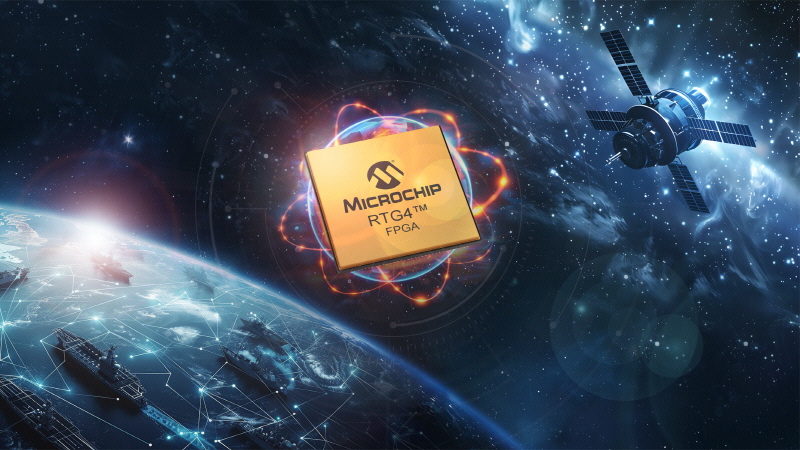마이크로컨트롤러, 혼합 신호, 아날로그 반도체 및 플래시-IP 솔루션 분야의 세계적 리더인 마이크로칩테크놀로지(아시아 총괄 및 한국대표 한병돈)가 가장 중요한 우주 프로그램에서 요구하는 임무 보증 요건을 충족하기 위해 무연(Lead-free) 플립칩 범프 기술로 제작한 내방사선(RT, Radiation-Tolerant)의 RTG4™ 필드 프로그래머블 게이트 어레이(FPGA)가 Qualified Manufacturers List(QML) Class V 등급을 획득하며, 우주 산업용 부품을 위한 가장 높은 수준의 인증을 통해 뛰어난 제품 안정성 및 수명을 검증받았다.
무연 플립칩 범프 RTG4™ FPGAs QML Class V 인증
마이크로컨트롤러, 혼합 신호, 아날로그 반도체 및 플래시-IP 솔루션 분야의 세계적 리더인 마이크로칩테크놀로지(아시아 총괄 및 한국대표 한병돈)가 우주 산업용 부품을 위한 가장 높은 수준의 인증을 통해 뛰어난 제품 안정성 및 수명을 검증받았다.
마이크로칩은 가장 중요한 우주 프로그램에서 요구하는 임무 보증 요건을 충족하기 위해 무연(Lead-free) 플립칩 범프 기술로 제작한 내방사선(RT, Radiation-Tolerant)의 RTG4™ 필드 프로그래머블 게이트 어레이(FPGA)가 Qualified Manufacturers List(QML) Class V 등급을 획득했다고 21일 밝혔다.
미국 국방부 산하 조달청(DLA, Defense Logistics Agency)에서 지정한 QML Class V 등급은 우주 산업에서 쓰이는 부품에 대한 가장 높은 수준의 인증으로, 유인 우주 탐사, 심우주 탐사, 국가 안보와 같은 중요한 우주 임무에 필요한 필수적 인증 단계다.
QML 인증은 DLA가 정한 특정 성능 및 품질 요건을 기준으로 표준화되어 있기 때문에, 고객들은 QML 인증 제품을 사용함으로써 설계 및 인증 프로세스를 더욱 간소화할 수 있다.
RTG4 FPGA는 15만개 이상의 로직 요소를 제공하는 RT FPGA 중 최초로 2018년에 QML Class V 인증을 획득했으며, 이번에 출시한 무연(Lead-free) 플립칩 범프 기술을 적용한 차세대 솔루션은 업계 최초로 QML Class V 인증을 달성했다.
RTG4 FPGA에 사용되는 것과 같은 고급 플립칩 패키지 구조에는 실리콘 다이와 패키지 기판을 연결하기 위해 플립칩 범프가 사용된다.
무연 범프 소재는 제품의 수명을 연장하는데 도움이 되며, 이는 우주 임무를 수행하는 데 있어 매우 중요하다.
마이크로칩 FPGA 사업부 브루스 바이어(Bruce Weyer) 부사장은 “RTG4 FPGA는 우주 비행 시스템을 설계하는 고객들에게 높은 신뢰성과 구성 오류가 없는 강력한 안정성, 효율적인 저전력 소비라는 이점을 제공한다는데 있어 마이크로칩의 중요한 성과이자 이정표가 되는 제품이다. 마이크로칩은 60년 이상 우주 비행 임무에 필요한 솔루션을 제공해 왔으며, 제품의 오랜 수명과 업계 최고 품질의 솔루션을 제공하기 위해 최선을 다하고 있다”고 밝혔다.
RTG4 FPGA는 우주 산업용 애플리케이션에 고밀도의 고성능을 제공하도록 설계되었으며, 전력 소비가 적고 설정 오류에 강해, 비용과 설계에 필요한 비용과 노력을 절감할 수 있다.
SRAM 기반의 FPGA와 달리, RTG4 FPGA는 정적 전력을 매우 적게 사용해 우주선에서 자주 발생하는 열 문제를 관리하는 데 도움을 준다. RTG4 FPGA는 SRAM FPGA에 비해 전력을 훨씬 적게 소비하면서도 방사선 환경에 노출되더라도 설정 오류가 발생하지 않기 때문에 추가적인 방사선 보호 조치가 필요 없다. 이를 통해 설계 비용과 전체 시스템 비용을 절감할 수 있다.
QML Class V 인증을 받기 위해, 무연 플립칩 범프의 RTG4 FPGA는 -65℃부터 150℃사이의 온도를 견디는 최대 2,000번의 열 사이클을 포함한 엄격한 신뢰성 테스트를 거쳤다.
무연 플립칩 범프 인터페이스는 MIL-PRF-38535 검사 기준을 통과하였으며, 주석 수염(tin whiskers) 현상이 전혀 나타나지 않았다.
이 플립칩 범프는 FPGA 패키지 내부에 있기 때문에, 무연 범프 RTG4 FPGA로 전환하더라도 기존의 사용자 설계 방식, 리플로우 프로파일, 열 관리 또는 보드 조립 과정에 영향을 미치지 않는다.
마이크로칩은 방사선 강화 및 내성 솔루션을 포함해 업계에서 가장 포괄적인 우주 제품 포트폴리오를 갖추고 있다. 여기에는 기존 QML(Qualified Manufacturers List) 부품과 COTS(Commercial Off-The-Shelf) 부품 간의 구성 요소 격차를 해소하는 QML Class Q RT PolarFire® FPGA 및sub-QML FPGA도 포함되어 있다. 마이크로칩 FPGA와 혼합 신호 부품 번호 및 이에 해당하는 미국 국방부 산하 조달청(DLA) 도면 번호에 대한 전체 목록은 DLA 교차 레퍼런스 가이드를 통해 확인할 수 있다.
